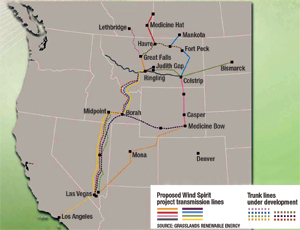Developers of an estimated $3-billion transmission system that will collect, store and distribute at least 3,000 MW of stranded renewable energy from wind-energy-rich western states and Canadian provinces to power-hungry regions elsewhere are seeking Federal Energy Regulatory Commission permission to move ahead.
Bozeman, Mont.-based Grasslands Renewable Energy, an entity created by Rocky Mountain Power, Calgary, Alberta, and Absaroka Energy LLC, Bozeman, wants FERC to allow it to negotiate deals with wind generators for the project, called Wind Spirit. Supplies of wind power would be generated by developers in Montana, North Dakota, Wyoming, Utah and the Canadian provinces of Alberta and Saskatchewan.
The $2.5-billion to $3-billion system would consist of about 1,300 miles of 230kV lines configured like a wheel, with spokes to connect several wind projects throughout the Northern Great Plains to larger trunk transmission lines that are being developed in the region. These areas include the Montana-Alberta Tie line; the Chinook line, being proposed by Calgary, Alberta-based TransCanada; and the Mountain States Transmission Intertie, being proposed by Northwestern Energy, Sioux Falls, S.D. Those trunk lines, in turn, will carry the wind power to markets in Nevada, California and many Midwestern states.
Grasslands Rewable Energy would also aggregate, store and make the electricity consistent by using a small pumped storage facility. The firm would negotiate and provide power at a consistent rate because wind in South Dakota could balance the system when wind is not blowing in Montana.
Windmaker Energy, headquareted in Whitefish, Mont., is one of 10 developers, with a total capacity of 3,000 MW, that have signed initial non-binding letters of intent with Grasslands. Three others are considering such agreements, and the company is continuing discussions with several other developers.
Jeff Arcel, CEO of Windmaker, says Grasslands is offering a “superior plan because of its opportunity to work with other wind developers to create a smart grid.” He adds, “Wind intermittency is a problem with getting a power purchase agreement.”
Hatch Energy, Mississauga, Ontario, has conducted studies for Grasslands that show that generator companies, which would pay for the system, would still profit from their wind supplies because they would be sold as a consistent and reliable product.
“There is a lot of opportunity to power the country with wind, and there’s tremendous need for transmission,” says Carl Borgquist, Grasslands president. “Developers are hungry for transmission to find a path to move that power someplace where it is needed.” Because development of the Wind Spirit project is contingent on construction of the larger trunk lines, however, he says it likely would not be operational until 2015 or 2017.
The unique transmission system is necessary because the wind is being developed in remote and sparsely populated areas with limited transmission. The proposed collector systems are an evolution from linear transmission systems intended to deliver massive amounts of electricity from a dam or a coal plant. But in the states where the wind projects are being developed, there is no local need for the electricity.
According to the Washington, D.C.-based American Wind Energy Association, which supports new transmission development, there are 300,000 MW of proposed wind projects in the U.S. that lack transmission to move generated supplies to market, says Michael Goggin, the group’s manager of transmission policy. Montana alone has 5,000 MW of wind farms under development, and that is a conservative estimate, says Tom Kaiserski, program manager for the state’s energy promotion and development office.
Borgquist points out that some of the region’s wind developers would have generation stranded without the project, but he acknowledges others are continuing to explore alternative options.


Post a comment to this article
Report Abusive Comment